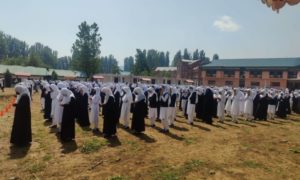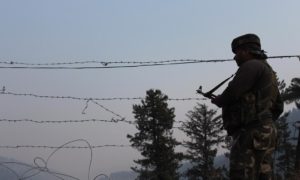As four fresh graves were dug after the Indian Armed Forces killed civilians around Shopian lately, the slaughter is likely to meet the fate of the earlier slaughters committed in this defiant apple town with an absolute sense of impunity.
As new graves keep coming on hillocks, meadows, playfields, brook bunds and the ever expanding martyrs cemeteries in southern Shopian district, the not-so-old graves are fast becoming a non-decrepit site of a weary past. Housing the war casualties—the fallen insurgents, these graves are equally packed with the collateral damage, which civilians become in action, of loose cannons in military ranks, whose ample presence gives a garrisoned face-lift to the otherwise serene apple town of Kashmir.
Four fresh graves of civilians—killed and passed as OGWs by the army lately—have apparently joined the fate of 17 graves: forgotten and fading, in want of justice.

The four slain youth of Shopian. Picture courtesy: The Wire
The slaughter took place on September 1, 1991 in Pulwama’s Niloora village—bordering the Shopian district—upon the arrival of the BSF troopers in search of militants. Even before gunning down the two insurgents in a paddy field, the troopers had already opened fire to kill four civilians.
“The firing continued till next the morning, shocking the entire village,” recalls Sanaullah Bhat, 60, of Niloora village. “The following day the villagers were even barred from performing the last rites of the slain persons when some 42 persons including the family members of the slain persons were arrested.” They remained in custody for seven days.
ALSO READ: Shopian Civilian Murders: Continuous deaths and endless mourning
Among the slain was 55-year-old farmer Sidiq Khan. When his mutilated dead body reached home, it left his family numb. “My father was working in his paddy field when the BSF party threw a grenade at him and left him dead and disfigured,” recalls Ghulam Mohi-u-din Khan, Sidiq’s son. “Now whenever forces kill boys for the heck of it, I see my father dying, all over again.”
There was one 18-year-old boy and Class XII student, Abdul Qayoom Bhat among the dead that day. Till today, his 72-year-old father keeps shedding tears in his longing and over the elusive justice.
“His Class 12 result was announced within days of his killing,” says Abdul Ahad Bhat, the distraught father. “He had passed the examinations with high grades.”

Graves of four civilians buried beside a mosque at Niloora village. (FPK Photo/Muhammad Raafi)
Then the forces moved towards the adjoining Aglar village in Shopian where they killed five civilians including a Class 10 student, Farooq Rather.
ALSO READ: The Slain Shopian Siblings: Even death didn’t do them part
“My brother had gone to a nearby hillock to play with his friends,” says Fayaz Rather, Farooq’s elder brother, “but the BSF party present there killed him along with two more civilians at the same spot. They killed another two civilians on the other side of the same hillock.”
One of them was a newly-wedded man.
“My husband Ghulam Muhammad Zoi was killed after being held captive by BSF,” says Azi Banoo, his widow. “We found his bullet-ridden body the next day.” Shocked Azi never married again. “How could I do that, after those cruel forces killed my groom so brutally?”

Graves of five persons at Shirmal graveyard killed at Aglar. (FPK Photo/Muhammad Raafi)
Even after piling nine bodies in one day, in two villages, the BSF troopers advanced further. And what happened next is perhaps like an unfolding plot of a crime thriller where the assassin behaves like a cold killer bereft of humanity.
The only survivor of that slaughter—who could have become grave no. 18 that day—is still shuddering over the manner in which that slaughter was carried out in Shopian’s Safnagri, after Niloora and Aglar.
“I was accompanying eight other villagers to go to the hillock to play,” Nazir recalls the day. “On the way, we saw armed BSF men calling us uphill, with hands up.”
ALSO READ: Emboldened 44 Rashtriya Rifles has been involved in various civilian killings, says JKCCS
Nazir, then 12, and his playmates, took a walk towards the gunners with trembling feet. “Unaware of the happenings around, one of the villagers opened the door of his house. He was shot dead right on the door,” he remembers.
Some 200 meters ahead where the BSF troopers were standing, Nazir and seven others were stripped, and forced to stand in a queue.
“We were frightened, trembling with fear,” he recalls, sighing amid shudders. “Then the BSF men killed five of my friends without reasoning, or talking to them. When my playmates fell down, bleeding on the ground, I could see how they were scratching the soil with their nails in extreme pain. How shall I explain this further? No, I can’t! I can’t…”
Nazir drops his head down, as if agonized to relive the pain of losing his playmates all over again. After some time, he ends the silence.
“Then it was my turn to get killed,” he resumes. “At that point, a woman from downhill started shouting at us. The BSF men asked me, ‘what is she saying?’ I lied to them, ‘she is my mother and is calling me down.’ But, no… she wasn’t calling me, but her son, Bashir, who was lying dead on ground,” Nazir wells up.
“Then one of the officers wrote something on my hand. ‘Go and show it to them [BSF troopers], if they try to stop you.’ I ran for my life, and fainted on my arrival in the village.”
Trembling with fear, Nazir didn’t divulge the slaughter details to the villagers and walked away from the village without attending the funeral of his friends. That evening, after a frantic search, the bodies of eight slain boys were found on the hillock, and taken down in the village amid massive mourning.

Graves of eight civilians buried in the Martyrs Graveyard at Safnagri village. (FPK Photo/Muhammad Raafi)
“When I returned to the village some months later, I would get flashbacks of the incident,” says Nazir, 40, living with his elderly parents, wife and children now. “I would see my dying playmates still scratching the soil with their nails and giving me a petrifying look while dying.” One of those playmates happened to be Fayaz Dar.
The only son of his parents, Fayaz was only 15 when killed by the forces. Today, his mother Jana Begum is living separately after being abandoned by her husband and daughter. “I am not even able to move on my own after two knee surgeries,” she says. “I wish Allah had taken me instead of my son, who was my support.”
Like in other human rights abuse cases in Kashmir, the state denial over this southern slaughter persists. Even the BSF denies having done anything like that.
“They may keep on denying these killings,” Nazir says, “but by releasing ex-gratia relief and compensation to the kin of slain civilians, the state has itself admitted that they were killed by the forces.”
But as the systematic denial continues to prevail over such civilian killings, the likes of Nazir fear that the recent Shopian killings might end up meeting the fate of September 1991 slaughter.
Like this story? Producing quality journalism costs. Make a Donation & help keep our work going.










